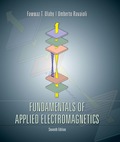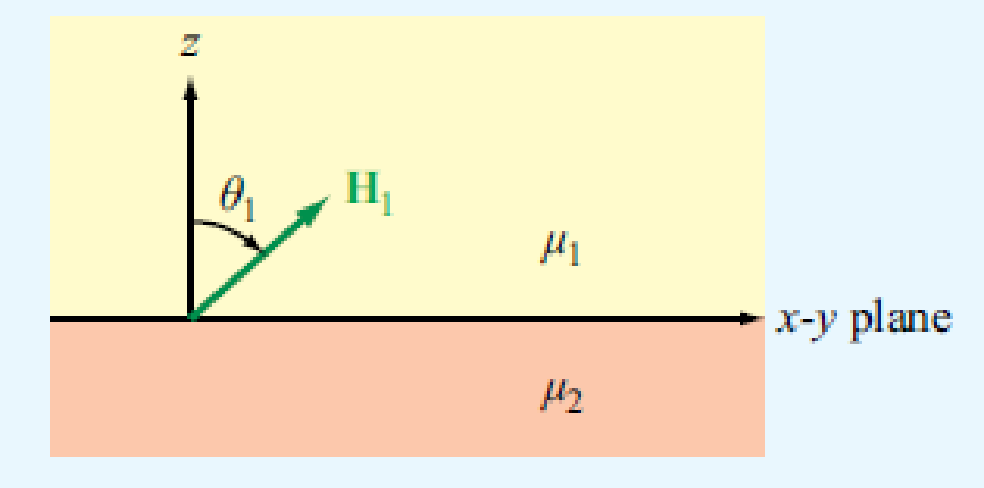
Concept explainers
The x–y plane separates two magnetic media with magnetic permeabilities μ1 and μ2 (Fig. P5.32). If there is no surface current at the interface and the magnetic field in medium 1 is
find:
- (a) H2
- (b) θ1 and θ2
- (c) Evaluate H2, θ1, and θ2 for H1x = 2 (A/m), H1y = 0, H1z = 4 (A/m), μ1 = μ0, and μ2 = 4μ0

Figure P5.32 Adjacent magnetic media (Problem 5.32).
Trending nowThis is a popular solution!

Chapter 5 Solutions
Fundamentals of Applied Electromagnetics (7th Edition)
- A four pole generator having wave wound armature winding has 51 slots ,each slot containing 20 conductors,what will be the voltage generated in the machine when driven at 1500rpm assuming the flux per pole is 7mWb Don't use Artificial intelligencearrow_forwardNeed Handwritten solution Do not use chatgpt Or AIarrow_forwardI need a detailed solution to a problem. The far-zone electric field intensity (array factor) of an end-fire two-element array antenna, placed along the z-axis and radiating into free-space, is given by E=cos (cos - 1) Find the directivity using (a) Kraus' approximate formula (b) the DIRECTIVITY computer program at the end of this chapter Repeat Problem 2.19 when E = cos -jkr 0505π $[ (cos + 1) (a). Elmax = Cost (case-1)] | max" = 1 at 8-0°. 0.707 Emax = 0.707.(1) = cos [(cose,-1)] (cose-1) = ± 0,= {Cos' (2) = does not exist (105(0)= 90° = rad. Bir Do≈ 4T ar=2() = = Bar 4-1-273 = 1.049 dB T₂ a. Elmax = cos((cose +1)), 0.707 = cos (Close,+1)) = 1 at 6 = π Imax (Cose+1)=== G₁ = cos(-2) does not exist. Girar=2()=π. 4T \cos (0) + 90° + rad Do≈ = +=1.273=1.049dB IT 2arrow_forward
- I need an expert mathematical solution. The E-field pattern of an antenna. independent of , varies as follows: 0° ≤ 0≤ 45° E = 0 45° {1 90° 90° < 0 ≤ 180° (a) What is the directivity of this antenna? (b) What is the radiation resistance of the antenna at 200 m from it if the field is equal to 10 V/m (rms) for Ø = 0° at that distance and the terminal current is 5 A (rms)?arrow_forwardI need an expert mathematical solution. The normalized far-zone field pattern of an antenna is given by E = {® (sin cos)/ 0 Find the directivity using 0 ≤ 0 ≤ π and 0≤ 0≤ π/2. 3m2sds2, elsewherearrow_forwardI need an expert mathematical solution. The radiation intensity of an aperture antenna, mounted on an infinite ground plane with perpendicular to the aperture. is rotationally symmetric (not a function of 4), and it is given by sin (7 sin 0) U π sin Find the approximate directivity (dimensionless and in dB) usingarrow_forward
- Waveforms v1(t) and v2(t) are given by:v1(t) = −4 sin(6π ×10^4t +30◦) V,v2(t) = 2cos(6π ×10^4t −30◦) V.Does v2(t) lead or lag v1(t), and by what phase angle?arrow_forward7.1 Express the current waveform i(t) = -0.2 cos(6 × 10°1 +60°) mA in standard cosine form and then determine the following: (a) Its amplitude, frequency, and phase angle. (b) i(t) at t=0.1 ns.arrow_forward3. Consider the RC circuit with a constant voltage source shown in the diagram below. The values of the resistor, capacitor, and input voltage are R = 50, C = 10 µF, and V = 6V, respectively. Assume that there is initially no charge on the capacitor before the switch is closed. Vo ↑i(t) R w C When the switch closes at time t = 0, the current begins to flow as a function of time according to the equation i(t) = ioencarrow_forward
- Q2. a) A three-phase 415 V, 4-pole, 50 Hz, A-connected induction motor was tested. The obtained results are: (i) (ii) No load test 50 Hz: Blocked rotor test, 10 Hz: DC test: Vnl=415 V, Pnl=1200 W, In=11 A Vbr 10 V, Pbr=1500 W, Ibr=91 A VDC 3 V, IDC=107 A Draw the per-phase equivalent electrical circuit of the motor Draw the circuits for no-load and block-rotor tests and indicate the slip for each of the tests. (iii) Identify the motor parameters (iv) Calculate the motor's starting torque at the rated voltage.arrow_forward4. Consider the RC circuit with a sinusoid voltage source shown in the diagram below. The values of the resistor, capacitor, input voltage amplitude and frequency are R-20012, C-5pF", Vo-10V, and w=500 rad/s, respectively. Assume that the circuit has reached steady state. Vрейте 2 The input voltage can be described using the complex sinusoid function V(t)-Vo and the physical voltage is obtained by taking the real part of V(t). The voltage drop across the capacitor is given by a sinusoid with same the frequency was the input voltage, but a different magnitude and different phase. In complex form, the capacitor's voltage is given by Vc(t)=1+jwRC For the following questions, use the template file Assignment TemplateQ2.m as the starting point for your MATLAB code. (a) (6 marks) Use MATLAB to make a graph that shows the real part of the input voltage source ReV(t)] and the real part of the voltage drop across the capacitor Re[Ve(t)] as a function of time. Choose the time scale so that two…arrow_forwardConsider the microgrid given in figure 8-56. The positive sequence impedance of the transmission Lines is given in -line diagram (figure 8.5%). The system data are as follows: the one PV generating Station: 2MW, 460V. AC, positive, negative and zero Sequence impedance of each line is equal to 10%. The generator negativ Sequence impedance is equal to the positive Sequence, and the Zero Sequence impedance is equal to half (½) of positiv Sequence impedance. Transformers positive sequence impedance is equal to the negative sequence and equal to the zero sequence impedance Station DC/AC CB Acpu bus CB www S+js 5 1+jlo M 2 T2 SB CB A Jus -3+16 local utilityarrow_forward
 Introductory Circuit Analysis (13th Edition)Electrical EngineeringISBN:9780133923605Author:Robert L. BoylestadPublisher:PEARSON
Introductory Circuit Analysis (13th Edition)Electrical EngineeringISBN:9780133923605Author:Robert L. BoylestadPublisher:PEARSON Delmar's Standard Textbook Of ElectricityElectrical EngineeringISBN:9781337900348Author:Stephen L. HermanPublisher:Cengage Learning
Delmar's Standard Textbook Of ElectricityElectrical EngineeringISBN:9781337900348Author:Stephen L. HermanPublisher:Cengage Learning Programmable Logic ControllersElectrical EngineeringISBN:9780073373843Author:Frank D. PetruzellaPublisher:McGraw-Hill Education
Programmable Logic ControllersElectrical EngineeringISBN:9780073373843Author:Frank D. PetruzellaPublisher:McGraw-Hill Education Fundamentals of Electric CircuitsElectrical EngineeringISBN:9780078028229Author:Charles K Alexander, Matthew SadikuPublisher:McGraw-Hill Education
Fundamentals of Electric CircuitsElectrical EngineeringISBN:9780078028229Author:Charles K Alexander, Matthew SadikuPublisher:McGraw-Hill Education Electric Circuits. (11th Edition)Electrical EngineeringISBN:9780134746968Author:James W. Nilsson, Susan RiedelPublisher:PEARSON
Electric Circuits. (11th Edition)Electrical EngineeringISBN:9780134746968Author:James W. Nilsson, Susan RiedelPublisher:PEARSON Engineering ElectromagneticsElectrical EngineeringISBN:9780078028151Author:Hayt, William H. (william Hart), Jr, BUCK, John A.Publisher:Mcgraw-hill Education,
Engineering ElectromagneticsElectrical EngineeringISBN:9780078028151Author:Hayt, William H. (william Hart), Jr, BUCK, John A.Publisher:Mcgraw-hill Education,





